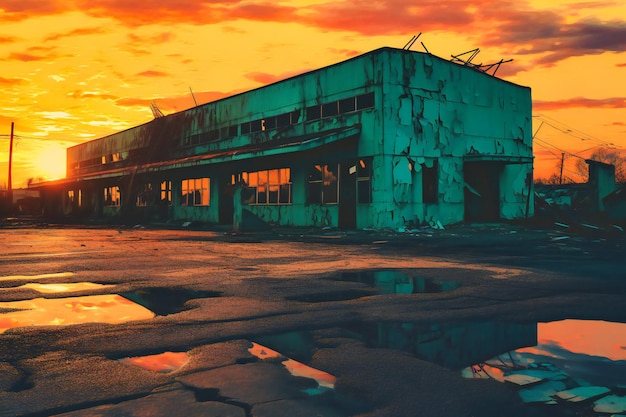Abandoned factories echo tales of a lost era

The world is filled with remnants of industrial ambition, and abandoned factories serve as poignant reminders of a bygone era. These structures, once bustling with activity and purpose, now stand silent, their walls echoing stories of labor, innovation, and economic change. In this article, we’ll delve into the fascinating histories of some of these forgotten sites, exploring what they reveal about our past and what they can teach us about the future.
The Rise and Fall of Industry
In the early to mid-20th century, factories were the heartbeats of many cities, providing jobs and driving local economies. As technology advanced and globalization reshaped production, many factories were left behind. The transition from manufacturing to service-oriented economies left vast, sprawling complexes abandoned and often in disrepair.
These abandoned factories serve as a stark contrast to modern industrial facilities. While some have been repurposed, many remain as haunting reminders of economic shifts. They tell the stories of hardworking individuals and communities that relied on these establishments for their livelihoods.
Architectural Beauty in Decay
Beyond their historical significance, abandoned factories possess a unique aesthetic appeal. The juxtaposition of decaying structures with nature’s reclamation creates a captivating visual narrative. Rusted machinery, broken windows, and crumbling walls serve as canvases for urban explorers and photographers, eager to capture the beauty in decay.
The architecture of these factories is often striking, showcasing the industrial design of their time. Massive brick walls, large windows, and intricate ironwork tell a story of craftsmanship and ambition. Each structure has its own unique personality, shaped by the processes that took place within its walls.
The Allure of Urban Exploration
For many, exploring abandoned factories is a thrilling adventure. Urban explorers seek to uncover the hidden stories behind these sites, often sharing their findings through photography and social media. This movement has grown, allowing a wider audience to appreciate the beauty and history of these forgotten places.
Urban exploration not only highlights the aesthetic appeal of these sites but also encourages discussions about their future. Through photography, explorers document the degradation and beauty of these locations, creating a dialogue about preservation and adaptive reuse.
The Cultural Significance of Abandoned Factories
The cultural significance of these sites cannot be understated. They serve as physical representations of a community’s industrial heritage, fostering a sense of nostalgia and prompting discussions about economic change and urban renewal. Many local historians advocate for the preservation of these structures, arguing that they provide valuable lessons about the rise and fall of industries.
Each factory tells a unique story, from the workers who toiled within its walls to the economic forces that led to its decline. Many communities have organized tours or events around these sites, turning them into educational opportunities for locals and tourists alike.
The Future of Abandoned Factories
While many abandoned factories face demolition, there is a growing trend toward adaptive reuse. Communities are beginning to recognize the value of these historic sites, transforming them into spaces for arts, culture, and commerce. Examples include the conversion of old textile mills into loft apartments, galleries, and creative workspaces.
This approach not only preserves the architectural integrity of these buildings but also revitalizes neighborhoods. It can attract new businesses and residents, breathing new life into once-neglected areas. By embracing the past, communities can create vibrant, sustainable futures.
Success Stories of Reuse
Some notable examples of successful adaptive reuse include:
- The High Line in New York City: A former elevated railway transformed into a public park, showcasing art and nature.
- The Tate Modern in London: An old power station repurposed as a contemporary art museum, drawing millions of visitors each year.
- The Ponce City Market in Atlanta: A historic Sears warehouse converted into a mixed-use development with shops, restaurants, and offices.
These projects demonstrate how abandoned factories can be reborn, serving new purposes while preserving their historical essence.
Why Visit Abandoned Factories
Visiting abandoned factories offers a unique glimpse into history. Here are a few reasons to explore these sites:
- Educational Value: Learn about industrial history and its impact on local communities.
- Photography Opportunities: Capture stunning images of decay and nature’s reclamation.
- Cultural Insights: Understand the evolution of work and industry in society.
- Adventure: Experience the thrill of exploration and discovery.
- Connection to the Past: Reflect on the labor and lives that once animated these spaces.

For those seeking adventure and a deeper understanding of our industrial past, abandoned factories are captivating destinations. They tell stories of resilience, change, and the enduring human spirit.
Conclusion
Abandoned factories echo tales of a lost era, inviting us to reflect on the journey of industrialization and its lasting impact on our society. As we explore these remnants of history, we gain insight into the past and inspire future generations to appreciate the narratives embedded in our built environment. Whether through urban exploration or adaptive reuse, the stories of these factories will continue to resonate, reminding us of the triumphs and challenges of the industrial age.
